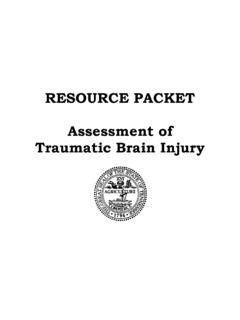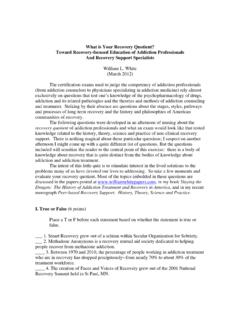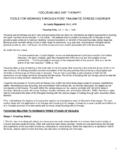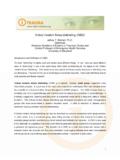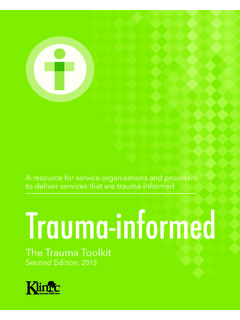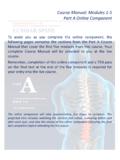Transcription of Seeking Safety - alrest.org
1 Seeking Safety 1 Seeking Safety : A Treatment Manual for PTSD & Substance Abuse Written by Lisa Najavitz Guilford Press, 2002 2 Lisa M. Najavits, Professor of Psychiatry, Boston University of Medicine; Lecturer, Harvard Medical School; Psychologist at the VA Boston Healthcare System & McLean Hospital Seeking Safety is an approved evidence-based practice listed on the SAMHSA NREPP Registry as a treatment for clients with a history of trauma (alone) & substance abuse. Designed for use: Group, individual, male/female, in a variety of settings ( residential, outpatient, in-patient, etc.) 3 Seeking Safety Therapy Seeking Safety is a present-focused, evidence-based, cognitive-behavioral treatment for PTSD and/or substance abuse Treatment developed to be first-stage therapy for clients with either PTSD, substance abuse or other addictive behaviors are appropriate.
2 Both disorders do not need to be present in order to benefit from Seeking Safety 4 Treatment Manual Important: Read the Manual Treatment manual comprised of: Overview of theory & treatment model Guidance for individual & group therapy application 25 topic areas addressing coping skill development & recovery Each topic area includes a Safety -oriented skill relevant to both PTSD & substance abuse Each topic is independent of the others Topic areas provide overview for therapist & handouts for participants 5 Seeking Safety Based on Three Stage Model of Recovery (Herman, 1992) Safety is the initial process of the treatment; the only stage which Seeking Safety focuses Mourning & reconnection are later stages of recovery initiated in therapy work separate from Seeking Safety skills 6 Seeking Safety Principles Five Central Principles: as the goal & priority in treatment treatment of PTSD, SA & other addictive behaviors (smoking, excessive spending, gambling, pornography, etc.)
3 On ideals: Restoring lost ideals content areas: Cognitive, behavioral, interpersonal & case management to therapist process 7 Najavitz, L. (2002) Seeking Safety Principles Safety - Examples: Stopping self-harm Gaining control over extreme symptoms Letting go of dangerous relationships Developing self-care 8 Not Part of Seeking Safety Exploring past trauma Okay to name trauma Reference page 46 for keeping discussion of trauma in safe parameters Interpretive psychodynamic work Homework (rather than Commitments ) Goal setting at the start Writing & autobiography Linking every substance use to PTSD 9 Najavitz, L. (2002). Seeking Safety New York: Guilford Press Screening, Assessment & Orientation Screen and assess as relevant to adult, adolescent or child Recommend 1:1 orientation session that covers pp.
4 88-93 in Seeking Safety manual Orient on how trauma will be addressed Answer individual questions & concerns Review risks/benefits ( worsening symptoms possible) 10 Treatment Format Session Format: Introduction: (5-10 min): BRIEF Quotation: What s the main point of this quote? Topic: Facilitator does not read discussion Grounding techniques & Coping Sheets may be used as needed to Recovery Handout (5-10 min): Leave enough time! Questionnaire 11 Najavitz, L (2002) Quick Reference Checklist before beginning treatment p. 52 List of treatment topics p. 57 Session Format p. 54 Check-in and check out p. 55 Core concepts of treatment (Participant handout) p.
5 56 End-of-session Questionnaire (Participant handout) p. 60 Certificate of Achievement p. 61 12 Seeking Safety Tips for Therapist Stay with the Seeking Safety format ( ) Prior to the session or group, read manual & review facilitator section Keep handouts organized & photocopied Relate material to what is current in participants lives Do more listening than talking Strive for balanced participation 13 Website Resources A website with a wealth of information especially in the areas: Research articles, outcomes, & adherence information. Trauma Resource Institute: Compassion without Borders Community Resiliency Model, Trauma Resiliency Model SAMHSA National Registry of Evidence-based Programs & Practices (NREPP) 14 Session Walk Through: Compassion 15 Session Format 5 min per client.
6 Allows clients to share how they are doing, issues to discuss in main session, consistent start. Quotation to session (briefly) today we will focus on Compassion. Ask about what they think the essence of the quote is. the topic to clients lives (in-depth, most of the session) via the handouts 16 Session Content Goals: Contrast harsh vs compassionate self-talk Handout 1 Rehearse compassionate self-talk Handout 2 Ways to relate topic to clients lives Role play Identify recent situation Create a cassette tape of compassionate self-talk. Discuss questions, feelings, thoughts with Commitment to Recovery Handout (5-10 min): Leave enough time!
7 Questionnaire 17


